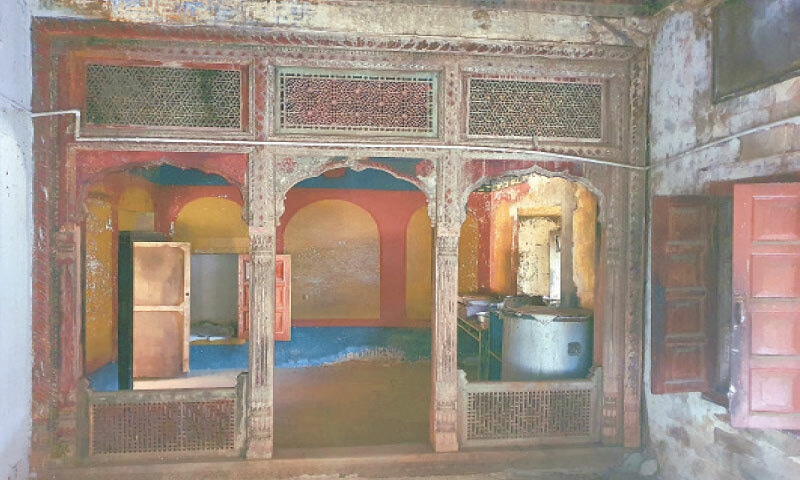Just 52 km from Islamabad, in the town of Kallar Syedan, there is a palatial house (now within the compound of the government boys’ high school) known as the Khem Singh Bedi Mahal. This three-story house, built on strong foundations and stout pillars at its corners, has been enduring neglect. Its wooden roofs have started to cave in, and the beautiful wooden planks, bearing artistic woodwork, have begun to deteriorate. From the grand entrance to the square compound bordered with arched verandas, the arches feature colourful frescoes intermingling Mughal and Sikh art, with dominant blue, red, pale, and green paints showcasing pictures of Sikh, Mughal, and even Hindu personalities and deities amid flowers. This presents a beautiful spectacle, although the colours are fading and the paintings are getting spoilt due to lack of upkeep. Despite neglect, the palace still retains its tattered pride and splendour, reflecting the princely influence once enjoyed by its owner, Khem Singh Bedi, who had it constructed in 1860.

Raja Muhammad Raza Vaince, a retired senior headmaster of a Kallar Syedan area school, told Dawn that the main residential area is confronted by a single-lined guest house at the northeastern end of the compound. Some classrooms from the high school were annexed to the palace, and during those days, teachers and students were conscious of its upkeep and routine maintenance. Mr Vaince mentioned that General Tikka Khan, while acting as governor of Punjab in 1989, had a new block built for the high school, and classwork in the palace was abandoned. This led to the decay of this heritage site. According to the former teacher, there was also a guest house adjacent to the main building and stables for horses at the back, which are now missing.
House with over two dozen rooms built by Khem Singh Bedi in 1860 retains past splendour, intricate woodwork despite decay
“The palace consists of about 25 rooms and two basements. The walls are quite wide and strong, and the woodwork on the ceilings, doors, windows, and even galleries inside is wonderful and needs urgent repair. The air intake channels serve as natural air conditioners, providing cool air during the summer, even in the basements. Fireplaces in the large rooms and halls remind us of the past glory,” the educationist said. The main entrance also has a fading fresco of Khem Singh Bedi’s face, and the stout doors of the entrance are reinforced with heavy iron bars protruding from the walls to fortify the closed doors in case of an attack.

Just in front of the palace, there is a rectangular marble platform that was used as a throne by Baba Khem Singh Bedi. According to Chaudhry Muhammad Ashraf, it was used as a throne during open sessions by Baba Khem Singh Bedi, who was also the 13th direct descendant of Baba Guru Nanak. Mr Ashraf, a retired senior bureaucrat and a student of Gurmukhi during pre-partition days, translated the Gurmukhi inscriptions on the marble. One such inscription mentioned Bhatia Raam Singh Jee, a donor, in the early 1900s. Chaudhry Muhammad Ashraf pointed out that if all the Gurmukhi inscriptions on the marble are cleaned, they could be read clearly.

While narrating historical facts about Baba Khem Singh Bedi (1832-1905), Raja Raza Vaince said that he was born to Baba Uttar Singh Bedi in Kallar Syedan. Khem Singh Bedi had inherited jagirs in the Doaba region, along with 41 villages in Depalpur Tehsil. During the 1857 uprising, Baba Khem Singh assisted the British in quelling local revolts in the Gugera district and elsewhere. In recognition of his loyalty to the British rulers, he was awarded vast land. He was also appointed as an honourary magistrate in 1877 and an honourary munsif in 1878. He was made Companion of the Indian Empire (C.I.E.) in 1879 and was nominated to the Viceroy’s Legislative Council in 1893. According to the retired teacher, he was among the first non-official members nominated to the Punjab legislature when the Indian Council Act was extended to Punjab in 1897. He was knighted in 1898.

Sir Khem Singh Bedi had also founded a society called Sri Guru Singh Sabha to promote Sikhism in united India. According to the retired teacher, in 1856, the office of Director of Public Instructions (DPI) was established in Lahore by the Punjab government of British India, and 30 ‘single-teacher primary schools’ were opened. Baba Khem Singh Bedi extended his full support and opened many schools, funding accommodations and boarding for poor students in Rawalpindi. On the occasion of his beloved daughter’s marriage in 1893, he donated Rs 300,000 for religious and charitable purposes, half of which was used to establish a college in Rawalpindi city. He died in Montgomery on April 10, 1905.

Gurbakhsh Singh, one of his six sons, according to the Gazetteer of the Rawalpindi District (page 217), “was a 3rd-class magistrate, and his jurisdiction covered Gujar Khan and Kahuta tehsils, except for the village of Daultala in Tehsil Gujar Khan.”

In light of the historical importance of this building, people urged Chief Minister Maryam Nawaz Sharif to take notice of the decay and direct its urgent repair and renovation.
Published in Dawn, February 24th, 2025













































